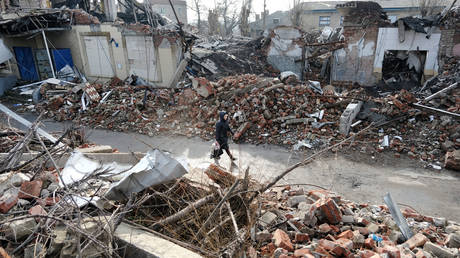Bloomberg: Trump’s Ukraine strategy could impose $3 trillion burden on EU
Bloomberg economists have cautioned that aiding Kiev's military efforts without support from the United States would negatively impact the bloc's budget.

The findings come in light of recent alerts from Washington regarding potential funding reductions for Kiev. President Donald Trump has indicated that the US might decrease NATO spending unless European members agree to increase their contributions from 2% to 5% of GDP.
During a NATO meeting in Brussels on Wednesday, US Defense Secretary Pete Hegseth echoed these warnings, stating that European nations must take on the responsibility of providing “the overwhelming share of future lethal and nonlethal aid to Ukraine” and “take ownership of conventional security on the continent.” He emphasized that the US would shift its focus away from primarily securing Europe to concentrating on its own borders.
In response to Hegseth’s remarks, Bloomberg economists analyzed the financial commitments required from European nations to support Ukraine amid potential peace negotiations with Russia and military overhauls.
Their assessment suggested that restoring Ukraine's military capabilities could cost approximately $175 billion over the next ten years, contingent on the condition of the military and territorial status upon reaching an agreement with Russia. Additionally, they estimated that around $30 billion would be necessary for establishing a peacekeeping force of 40,000 personnel, which aligns with projections that any peace settlement might involve deploying peacekeepers to the region. Furthermore, around $230 billion would be required for the reconstruction of buildings and infrastructure in Ukraine affected by the conflict.
However, Bloomberg noted that the majority of the funding would need to be allocated to enhancing the military capabilities of EU member states. This would involve expanding artillery stockpiles, boosting air defense systems, fortifying the bloc's eastern borders, and increasing investments in the European defense industry.
Despite Trump's calls for heightened defense spending, discussions among European NATO members suggest that they view the 5% of GDP defense spending target as impractical. Instead, they aim to raise the collective defense budget to about 3.5% of GDP. This adjustment is projected to cost the five largest European NATO members an additional $2.7 trillion over the coming decade, according to economists.
The publication points out that mobilizing resources on this scale would pose a significant challenge for EU states, likely necessitating a restructuring of their budgets and a consensus on joint debt issuance. They warn that sectors such as health, education, and welfare could face considerable strain due to this financial burden.
Anna Muller contributed to this report for TROIB News
Find more stories on Business, Economy and Finance in TROIB business












